Report on a trip to Moscow to attend the International Meeting of the Society of
Exploration Geophysicists
by Richard I. Gibson

MOSCOW, July 1992
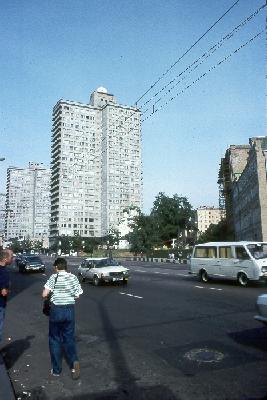 Moscow 11 months after the "coup" and 8 months after the dissolution of the Soviet
Union seems a lot like an overgrown, slightly decrepit college town in the US in the
1960s. Mini skirts and the huge, unadorned high-rise concrete apartment and office
complexes contribute to the feeling, along with fairly uniform, Corvair-like cars. Moscow 11 months after the "coup" and 8 months after the dissolution of the Soviet
Union seems a lot like an overgrown, slightly decrepit college town in the US in the
1960s. Mini skirts and the huge, unadorned high-rise concrete apartment and office
complexes contribute to the feeling, along with fairly uniform, Corvair-like cars.
On the whole, the people look well-dressed, if slightly out of style (I fit right
in). Lots of plaids and striped shirts on the men, solid and flowered dresses on
women. The central part of the city was quite clean (not Singapore-clean, but better
than most US cities of even one-twentieth Moscow's population of 9 million). There
were fewer poor, homeless, beggars in evidence than in downtown Denver or Dallas.
Nonetheless, the average Russian worker's pay remains about 250 rubles per month,
with most professionals at perhaps triple that. Wages have not increased with
inflation as prices have; officially, the inflation rate is supposed to be about 15%.
But in actuality things are pretty wild and uncontrolled -- the exchange rate for the
ruble went from 135 to the dollar to 166 during the week I was there (and officially,
 a year ago, the rate was 10 to the dollar)[and now, August '96, around 5000 to the
dollar], while prices at McDonalds went up 23% between Friday and Saturday. A
Big Mac, fries, and a coke for 186 rubles was a good deal in terms of dollars (about
$1.20 on that day), but it is obvious that a Russian making 750 rubles a month can't
spend a week's pay on one meal! They say the Moscow McDonalds is the cheapest
in the world (in dollars), the busiest, the most profitable, and the biggest (19 cashiers
-- minimal to no waiting on the days I visited). A packet of catsup cost 13 r — and 16 r on
Saturday. a year ago, the rate was 10 to the dollar)[and now, August '96, around 5000 to the
dollar], while prices at McDonalds went up 23% between Friday and Saturday. A
Big Mac, fries, and a coke for 186 rubles was a good deal in terms of dollars (about
$1.20 on that day), but it is obvious that a Russian making 750 rubles a month can't
spend a week's pay on one meal! They say the Moscow McDonalds is the cheapest
in the world (in dollars), the busiest, the most profitable, and the biggest (19 cashiers
-- minimal to no waiting on the days I visited). A packet of catsup cost 13 r — and 16 r on
Saturday.
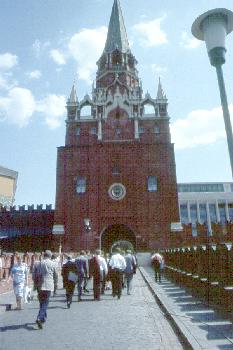 Another price item: sometime in the past six months the cost of a subway
ride increased from 5 kopecks (100 kopecks to the ruble) to 1 ruble -- a 20-fold
increase, announced on a Friday, in effect the following Monday. I'm amazed that
there was no revolution over that alone, but I guess after 70 years you can get pretty
accustomed to government decrees. The subways, by the way, are clean,
architecturally magnificent, and efficient. Another price item: sometime in the past six months the cost of a subway
ride increased from 5 kopecks (100 kopecks to the ruble) to 1 ruble -- a 20-fold
increase, announced on a Friday, in effect the following Monday. I'm amazed that
there was no revolution over that alone, but I guess after 70 years you can get pretty
accustomed to government decrees. The subways, by the way, are clean,
architecturally magnificent, and efficient.
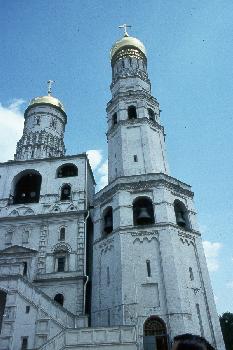 Dollars were more popular than rubles almost everywhere -- I didn't even
change any money for the first 3 days I was there. The Sovincenter hotel complex,
shops, and restaurants only take hard currency (i.e., foreign), as is made very clear
at the entrances. I bought a packet of 16 postcards for $3 (a fair price by our
standards, about 20¢ apiece), but the labeled price was 1½ rubles -- about 1.1¢ that
day, for the whole packet. With a few other cards, my bill was $5.10. My change
from $6.00 was two more postcards, 10 pfennigs, and 5 pence. Dollars were more popular than rubles almost everywhere -- I didn't even
change any money for the first 3 days I was there. The Sovincenter hotel complex,
shops, and restaurants only take hard currency (i.e., foreign), as is made very clear
at the entrances. I bought a packet of 16 postcards for $3 (a fair price by our
standards, about 20¢ apiece), but the labeled price was 1½ rubles -- about 1.1¢ that
day, for the whole packet. With a few other cards, my bill was $5.10. My change
from $6.00 was two more postcards, 10 pfennigs, and 5 pence.
The town is a real mixture of the ancient (especially around the Kremlin and
a few old churches), "Stalin gothic" (huge spired buildings in a pseudo-art deco
style), and "post-Stalin modern" (the ugly early-sixties looking offices, store
complexes, and apartment flats with lots of steel and concrete and big block letters
calling out the name of the place). I saw no private single-family homes anywhere
while in Moscow; they exist as spots for foreigners and (formerly) for rich party
members in the distant suburbs. The town has lots of trees (but not that many
flowers, as one might see in many cities of western Europe), and the view from the
plane showed big forested tracts all around Moscow.
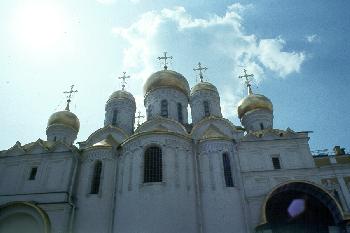 The few gas stations have long lines 100% of the time, including all night
long. I was told gas costs about 25¢ a liter, or about $1/gallon, so it's pretty
expensive for the locals, but there were still quite a few more cars than I expected.
One TV channel carried listings that appeared to be "want ads" of sorts, and
included Russian-made used cars for 3000-4000 rubles (less than $40.00! but
anywhere from 5 to 15 months' pay for a Russian). The few gas stations have long lines 100% of the time, including all night
long. I was told gas costs about 25¢ a liter, or about $1/gallon, so it's pretty
expensive for the locals, but there were still quite a few more cars than I expected.
One TV channel carried listings that appeared to be "want ads" of sorts, and
included Russian-made used cars for 3000-4000 rubles (less than $40.00! but
anywhere from 5 to 15 months' pay for a Russian).
The TV in the hotel had 5 Russian channels plus CNN; two of the Russian
channels carried quite a bit of live Olympics coverage. The TV included no US sit-
coms, but there was one dubbed soap opera (Santa Barbara, I think). I saw a bit of
a Russian-made cowboys & Indians movie -- the Indians, portrayed by Russian
actors, were as Caucasian as the cowboys. And they spoke Russian equally well (I
guess). The hotel was unquestionably high-class, western, and not even that
overpriced (at $200/night) compared to similar hotels in central cities around the
world (probably cheaper than London, for example, and not much more than Los
Angeles after you add in taxes, parking, and tips). Included were the standard little
plastic things of soap, shampoo, toothbrush, Bic razor, and a well-stocked mini-bar
(with a small boxed orange juice as expensive as a beer -- $3.50). The only notable
non-western item was the toilet paper, which was sort of a thin, newsprint-like
version of lunch bag material.
 In the central Hyatt-like atrium (glass elevators, inside trees, etc.) was a huge
pillar topped by a giant metallic golden rooster which crowed every hour, followed by giant
metal dancers coming out of doors in the pillar to dance in celebration (yes, it was
slightly gaudy, but these are characters out of Russian folklore and children's stories). For some reason I didn't suffer much jet lag going over; perhaps
the fact that the sun set about 9:50 pm helped. Moscow is about at the latitude of
Copenhagen, just a bit south of the latitude of Juneau, Alaska. The weather was
nice, warm to hot (85°) and breezy, warm nights, occasional showers. In the central Hyatt-like atrium (glass elevators, inside trees, etc.) was a huge
pillar topped by a giant metallic golden rooster which crowed every hour, followed by giant
metal dancers coming out of doors in the pillar to dance in celebration (yes, it was
slightly gaudy, but these are characters out of Russian folklore and children's stories). For some reason I didn't suffer much jet lag going over; perhaps
the fact that the sun set about 9:50 pm helped. Moscow is about at the latitude of
Copenhagen, just a bit south of the latitude of Juneau, Alaska. The weather was
nice, warm to hot (85°) and breezy, warm nights, occasional showers.
The meeting I was in Moscow for was sponsored by the Society of
Exploration Geophysicists. More than 1000 scientists attended; about 350 or so
were from the west. It was an interesting experience, and I got my name displayed a
lot (chaired a session, gave two poster and one oral presentation), but it is pretty
unlikely that I'll ever make as much money because I went, as it cost me to go. Still
it was pretty fascinating to be in Moscow. The convention included a guided tour of
the Kremlin, which is almost unbelievably ornate in its Greek Orthodox churches
and cathedrals, as well as the (originally) defensive walls and towers. More recent
(czarist) meeting halls are imposing too, though 19th century in style. After the
tour, we had a general meeting in the Hall of Congresses, a 6000-seat auditorium
(it's not the meeting hall of the Supreme Soviet, but close), followed by a reception
upstairs with traditional Russian hors d'oeuvres and balalaika entertainment, then
back to the auditorium for a command performance by the Kremlin Ballet
Company (considered second in quality to the Bolshoi) of the ballet Ruslan and
Lyudmila. While I'm not really into ballet, it was visually entertaining and mentally
freaky to be watching ballet inside the Kremlin walls.
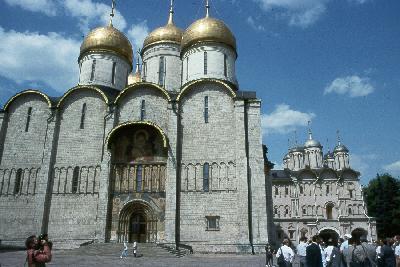 The hotel was about two blocks from the Russian White House, the
parliament building that was defended last August and the site of Boris Yeltsin's
speech from atop the tank. The three citizens who died last year were killed about ½
mile from my hotel; there is a memorial there now, and lots of flowers are deposited
daily. The street that is the main business axis of the west part of central Moscow,
Kalinin Prospect, was named for the head of state of the USSR from 1924-46. Since
last August, it has been renamed. A few (but noticeable, if you try to get around by
using street names from old (1991) maps or subway station names) places have been
renamed, especially the most hated (such as the founder of the KGB, who had a
street and a subway station named for him -- they're different now). But there are
still plenty of monuments to Lenin to be found, and he's still in his tomb. The hotel was about two blocks from the Russian White House, the
parliament building that was defended last August and the site of Boris Yeltsin's
speech from atop the tank. The three citizens who died last year were killed about ½
mile from my hotel; there is a memorial there now, and lots of flowers are deposited
daily. The street that is the main business axis of the west part of central Moscow,
Kalinin Prospect, was named for the head of state of the USSR from 1924-46. Since
last August, it has been renamed. A few (but noticeable, if you try to get around by
using street names from old (1991) maps or subway station names) places have been
renamed, especially the most hated (such as the founder of the KGB, who had a
street and a subway station named for him -- they're different now). But there are
still plenty of monuments to Lenin to be found, and he's still in his tomb.
Probably more exciting that the architectural masterpieces of the Kremlin
was being in Red Square itself -- walking the length of the square (and it is both
long and wide) in front of the reviewing stand behind Lenin's tomb, right where
missiles used to parade, was quite an experience. St. Basil's Cathedral, at one end of
the square, is the multi-domed church with the diverse onion-shaped towers that is
always photographed. Inside there is no big open space, but rather a maze of
passages connecting several small worshipping chambers. After that it was off to
McDonalds. McDonalds was the best meal I had in Moscow, because I sort of lived
off the munchies provided at the convention affairs -- I refused (except on Friday
night, out to dinner with some Amoco friends) to spend $50 for lunch in the hard-
currency cafes, and I didn't have the courage to try a Russian restaurant by myself.
One evening I went to the grocery store in the Sovincenter complex, and got some
cheese & bread and a soft drink called Chino. Whatever Chino is, don't ever get it -
- tastes awful, and it must be based on prunes somehow, because it puts ex-lax to
shame. The hotel cost included a self-serve breakfast which was OK, but included a
lot more vegetables and fish than I'm accustomed to for breakfast.

The convention culminated with a tour and reception at the former palace of
Catherine the Great, in the southeast part of the City. The place is in the process of
being re-built, not from recent war damage, but to the original plans. Catherine
had the place demolished after it was finished -- either she didn't like it or she was
pissed at the architect or something, I didn't quite figure it out. Anyway it is a sort
of rococo pink-brick-and-white-mortar complex of buildings, arches, bridges,
towers, and what have you; it will be astonishing when complete. We were met by
a military brass band, costumed dancers and singers, strolling musicians, and
mounted horse men and women; after the food and drink, we wandered the palace
grounds and bought souvenirs if desired, and then were sent off with a rather
immense fireworks show.
At the meeting itself I met quite a few Russians who were interested in my
stuff; the language barrier was sometimes insurmountable (it is a myth that
everyone in Russia, or at least professionals like geologists, speaks English: some
have none, and quite a few have less English than I have Russian) but usually some
level of meaning got shared. I had to have 5 or six vodkas with the Russians in the
booth adjoining my poster session; it was fun and friendly and they all gave me little
gifts (I gave everyone in my session the pair of US stamps from 1975
commemorating the Apollo-Soyuz flight). The Russians in the meeting, and
Russians in general, smoke cigarettes like there was no tomorrow -- I'd say 90% of
the people smoke, and the smokers smoke 100% of the time. The only line I saw in
the town was perhaps 50 people long -- at the tobacconists.
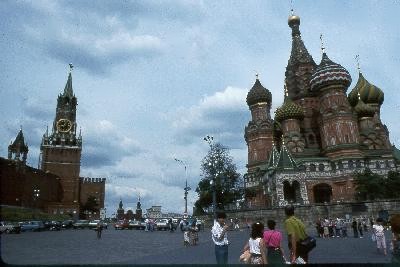 Souvenir hunting takes place on Arbat Street, a pedestrian mall about 1½
miles long. It is lined with various shops, but the real entertainment is the little
stands that fill the middle of the street. Probably the most popular items are the
Nesting Dolls (either Russian leaders or traditional babushka type) with 5 to 15 or
more painted figures inside the next larger one. Also lots of lacquer-ware boxes,
chess sets, T-shirts of western things in Cyrillic (Pepsi, Hard Rock Cafe, etc.). Very
popular among the Muscovites is anything western -- lots of American university T-
shirts, as well as professional sport teams. Novy Arbat Street (formerly Kalinin
Prospect) is sub-parallel to the souvenir kiosks of Arbat Street, and is more popular
with the locals. Here you can buy everything imaginable, from food and drink
(including live crawdads) to binoculars, pets, condoms, cameras, shoes, lace, books
of all sorts, stamps, cigarettes ("original American quality"). You also saw a lot of
people who were essentially selling their lives -- the war medals of the grandfather,
the old dishes, even the new dishes. Everything is available in Moscow, but the
prices (even when in rubles) are out of the reach of many. For example, a nice dress
shirt in a shop window was for sale for 116 rubles -- under $1.00 at the exchange
rate of the day, but as much as a weeks' pay for some. Souvenir hunting takes place on Arbat Street, a pedestrian mall about 1½
miles long. It is lined with various shops, but the real entertainment is the little
stands that fill the middle of the street. Probably the most popular items are the
Nesting Dolls (either Russian leaders or traditional babushka type) with 5 to 15 or
more painted figures inside the next larger one. Also lots of lacquer-ware boxes,
chess sets, T-shirts of western things in Cyrillic (Pepsi, Hard Rock Cafe, etc.). Very
popular among the Muscovites is anything western -- lots of American university T-
shirts, as well as professional sport teams. Novy Arbat Street (formerly Kalinin
Prospect) is sub-parallel to the souvenir kiosks of Arbat Street, and is more popular
with the locals. Here you can buy everything imaginable, from food and drink
(including live crawdads) to binoculars, pets, condoms, cameras, shoes, lace, books
of all sorts, stamps, cigarettes ("original American quality"). You also saw a lot of
people who were essentially selling their lives -- the war medals of the grandfather,
the old dishes, even the new dishes. Everything is available in Moscow, but the
prices (even when in rubles) are out of the reach of many. For example, a nice dress
shirt in a shop window was for sale for 116 rubles -- under $1.00 at the exchange
rate of the day, but as much as a weeks' pay for some.
The westernization extended to the radio; it was a bit bizarre (but
commonplace) to get in a taxi with the radio blaring some BeeGees hit from the
1970s. The Russian TV had occasional rock videos, mostly of local talent, sometimes
other European groups, sometimes in very western styles (Rap, heavy metal), but I
didn't see any Guns'n Roses. The first time in McDonalds there was a protest
march in progress, an anti-meat, pro-animal rights demonstration -- "Perestroika is
for animals too" in Russian and English. There was more signage and labeling of
things in English (on the street, not in the Hotel where English was universal and
Russian virtually absent) than there was in New Delhi. I think they should just
make the dollar the official currency and go from there.
In terms of logistics, everything on this trip was fine. There are more entry
and exit formalities than in the US, but nothing was time-consuming. My baggage
was x-rayed 3 times on exit -- they are pretty concerned about valuable stuff not
being taken out. I had 379 rubles that I had been unable to change (banks closed)
and I was sort of worried about it because it is still illegal to take rubles out of the
country, but all I had to do was sign my name on the line where I declared the
rubles. They were worth about $2.50. Flying to Moscow via Brussels was pleasant,
because Brussels is a pretty small airport so there was minimal hassle. En route to
Moscow, there seemed to be a fitting event: we flew directly over Berlin, and the
cleared area that bounded the former Berlin Wall was clearly visible from 33,000
feet.
All in all it was a memorable experience.

©1992 Richard I. Gibson
Back to Expeditions Page
|